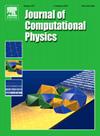A level set immersed finite element method for parabolic problems on surfaces with moving interfaces
IF 3.8
2区 物理与天体物理
Q2 COMPUTER SCIENCE, INTERDISCIPLINARY APPLICATIONS
引用次数: 0
Abstract
This paper addresses the challenge of solving parabolic moving interface problems on surfaces. These problems have diverse applications, including the Stefan problem, solidification of dendrites on solid surfaces, and flow patterns on soap bubbles. The main difficulties lie in accurately discretizing complex surfaces, efficiently processing interface jump conditions, and tracking the moving interface. Existing numerical methods for interface problems on surfaces have limitations, such as handling only homogeneous jump conditions, having first-order accuracy, or requiring body-fitted nodes. To overcome these limitations, this paper proposes a second-order accurate immersed finite element method (IFEM) for solving parabolic moving interface problems on surfaces. The method is extended to handle non-homogeneous flux jump conditions by enriching the basis functions on interface elements. Furthermore, a novel computational framework is proposed by combining the IFEM with the level set method to track the moving interface. This framework simulates the heat conduction process involving moving interfaces in different velocity fields. The innovation of this paper lies in its ability to handle moving interface problems on surfaces with improved accuracy, efficiency, and versatility compared to existing methods. Verified through numerical simulation, the proposed method and computational framework enable the simulation of a wider range of heat conduction with moving interfaces on surfaces.
具有移动界面的抛物问题的水平集浸入有限元法
本文解决了求解曲面上抛物运动界面问题的挑战。这些问题有不同的应用,包括Stefan问题,固体表面上枝晶的凝固,以及肥皂泡的流动模式。复杂曲面的精确离散、界面跳跃条件的有效处理以及运动界面的跟踪是该方法的主要难点。现有的表面界面问题的数值方法存在局限性,例如只能处理均匀的跳跃条件,具有一阶精度,或者需要体拟合节点。为了克服这些局限性,本文提出了求解曲面上抛物运动界面问题的二阶精确浸入有限元法。通过丰富界面元上的基函数,将该方法扩展到处理非均匀通量跳跃条件。在此基础上,提出了一种将水平集法与有限元法相结合的运动界面跟踪计算框架。该框架模拟了不同速度场中涉及运动界面的热传导过程。本文的创新之处在于,与现有方法相比,它能够以更高的精度、效率和通用性处理表面上的移动界面问题。通过数值模拟验证,所提出的方法和计算框架能够模拟更大范围的表面上移动界面的热传导。
本文章由计算机程序翻译,如有差异,请以英文原文为准。
求助全文
约1分钟内获得全文
求助全文
来源期刊

Journal of Computational Physics
物理-计算机:跨学科应用
CiteScore
7.60
自引率
14.60%
发文量
763
审稿时长
5.8 months
期刊介绍:
Journal of Computational Physics thoroughly treats the computational aspects of physical problems, presenting techniques for the numerical solution of mathematical equations arising in all areas of physics. The journal seeks to emphasize methods that cross disciplinary boundaries.
The Journal of Computational Physics also publishes short notes of 4 pages or less (including figures, tables, and references but excluding title pages). Letters to the Editor commenting on articles already published in this Journal will also be considered. Neither notes nor letters should have an abstract.
 求助内容:
求助内容: 应助结果提醒方式:
应助结果提醒方式:


